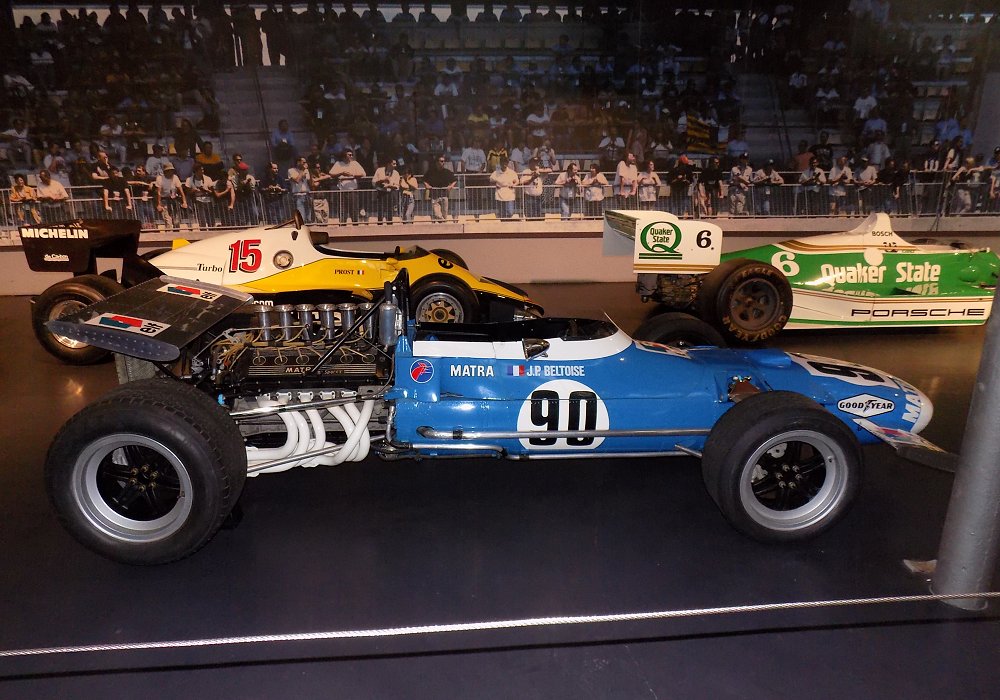Description
The Matra MS 11/12 represents one of the most important transitional phases in Matra’s early Formula One history — the moment when the small French constructor moved from modified customer cars (like the MS7 Formula Two–derived machines) into building a true Grand Prix chassis powered by its own ambitious V12 engine. Although results were mixed and reliability was often elusive, the MS 11/12 period remains crucial: it marked Matra’s first full commitment to Formula One and introduced the screaming French V12 that would become a motorsport icon.
The MS 11 was introduced for the 1968 Formula One season as Matra’s first dedicated Grand Prix car designed for the works team (distinct from the Ford-powered MS10 that Matra supplied to Tyrrell and Jackie Stewart). The car used a tubular spaceframe chassis, constructed with meticulous attention to stiffness and serviceability. Unlike the aluminium monocoques emerging from rivals such as Lotus and McLaren, Matra opted for a structure that prioritised durability and ease of modification at a time when the team was still learning the demands of Formula One engineering. The result was a relatively heavy but robust platform intended to support the ambitious new Matra V12 engine.
That engine — a 3.0-litre, 60-degree V12 — defined the MS 11/12 project. Producing around 390 horsepower in early tune, it was a high-revving, technically sophisticated unit with four overhead camshafts, twelve individual intake trumpets and a fuel-injection system adapted from Matra’s aerospace expertise. The engine delivered a glorious, soaring sound unmatched by anything else on the grid. However, its weight, complexity and demanding cooling requirements made it difficult to integrate effectively into a competitive Grand Prix package. Despite this, the V12 became the core of Matra’s identity and a source of immense national pride.
In 1968, the MS 11 appeared with increasingly elaborate aerodynamic additions — a hallmark of the period as teams experimented with wings and airflow management. Early versions carried modest front and rear wings, but as the season progressed Matra refined the package with taller rear aerofoils and altered nose arrangements. The car showed good mechanical grip and decent balance, particularly on flowing circuits, but it struggled against the lighter, more agile Ford-powered cars in both acceleration and agility. Jean-Pierre Beltoise, Matra’s lead driver for the works team, nonetheless produced several strong performances, including a memorable podium at the 1968 Dutch Grand Prix.
The MS 12, introduced in 1969, was essentially a refined evolution of the MS 11 rather than a clean-sheet design. Matra improved the spaceframe’s stiffness, reduced weight where possible and revised the suspension geometry for better response and stability. Aerodynamics continued to evolve rapidly, with wider wings, more pronounced endplates and improved airflow over the engine cover. Crucially, the V12 itself received internal refinements, including more reliable cooling channels, modified cylinder heads and more consistent fuel delivery. Output rose toward 410 horsepower, giving the car a stronger high-speed presence even if it remained heavier than the competition.
The MS 12 proved competitive in flashes. On fast circuits such as Clermont-Ferrand or Spa, the V12’s power and linear delivery gave the car real pace. Beltoise scored several strong finishes, and the car’s reliability began to improve. But the era belonged increasingly to lighter, more agile chassis-and-engine combinations, particularly the Ford Cosworth DFV–powered cars that defined the field. Matra’s works effort, while courageous, could not match the rapid development that came from outsourcing engines to the Tyrrell-Stewart partnership — a partnership powered by the MS10 and MS80 chassis rather than the heavier V12 works cars.
By the end of the 1969 season, Matra made the strategic decision to withdraw its own V12-powered works team from Formula One to focus resources on the rapidly evolving endurance programme. The MS 11/12 cars therefore represent Matra’s first bold attempt at creating a complete French Grand Prix car — chassis, aerodynamics and engine alike — before the company shifted its attention to the long-distance racing arena, where its V12 would eventually find its greatest success.
Today, the Matra MS 11/12 is remembered with fond admiration among enthusiasts. These cars may not have won championships, but they embodied the purity of a constructor determined to represent France in Formula One with fully domestic engineering. Their high-revving V12 soundtrack remains one of the most evocative in motorsport history, and their role in establishing Matra as a serious racing force cannot be overstated. They were the first step on a path that would ultimately lead to Le Mans glory and some of the finest racing prototypes ever built.
